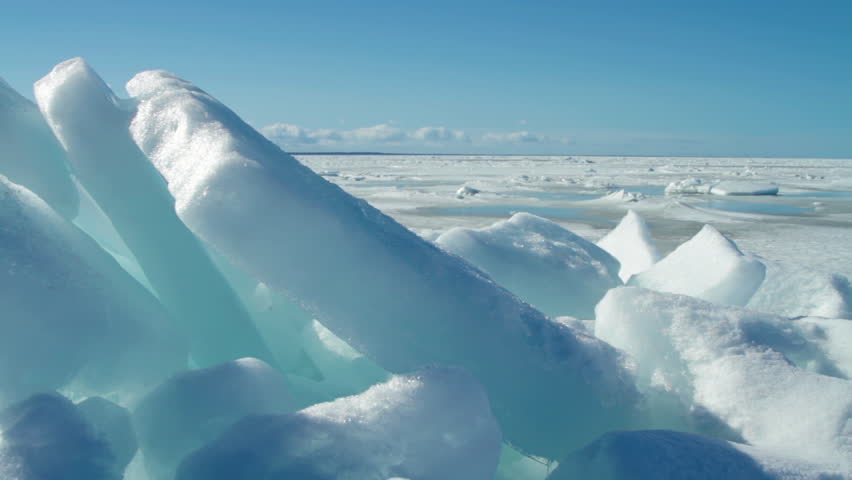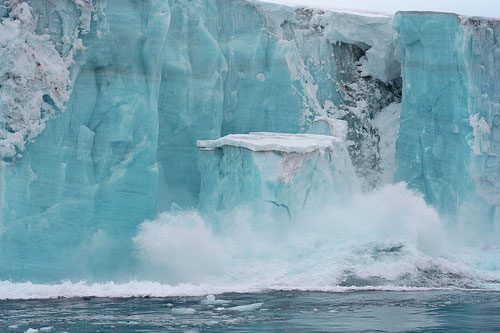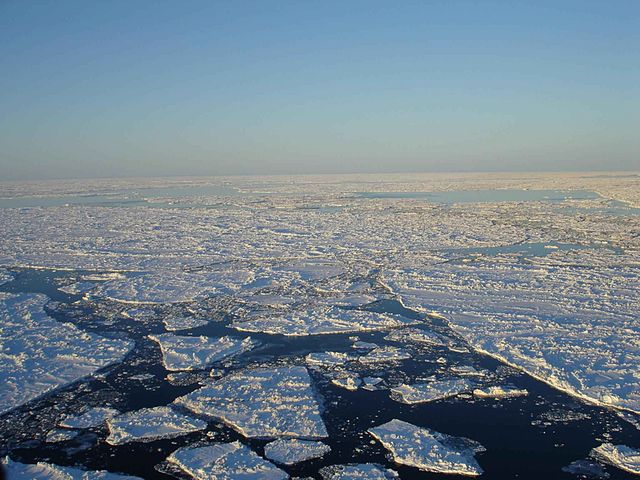 |
| Polar Ice Caps |
Ice covers Earth’s North and South Poles. Weak sunlight and long, dark winters at high latitudes (imaginary lines on Earth that tell how far north or south a place is from the equator) create frigid conditions that support the formation of year-round glaciers (large masses of moving ice) on land and seasonal ice in the oceans.
An ice cap is a permanent covering of ice over a large area. The arctic ice cap at the North Pole includes sea ice floating in the Arctic Ocean; glaciers in northern Asia, Europe, North America; and sheets of ice on the island of Greenland. The ice cap at the South Pole is made up of the massive Antarctic ice covering and ice in the Southern Ocean.
Polar ice caps play a vital role in regulating global climate, temperature, ocean currents, and sea level. They keep nutrientrich waters of the Arctic and Southern Oceans at a livable temperature for rich communities of biological life. A total of 99.997% of Earth’s fresh water is bound up in polar ice.
  |
Humans have lived in the North Pole area, the Arctic, for thousands of years and navigators have long been challenged by ice that blocks shipping and travel routes. Humans discovered the South Pole region, Antarctica, in the early 1800s. With the exception of explorers, scientists, and tourists, it remains uninhabited by humans today.
Ice sheets
 |
| ice sheets |
Most of Earth’s ice is bound up in immense ice sheets that cover the southern continent of Antarctica and the large arctic island of Greenland. Ice sheets, also called continental glaciers, are dome-shaped masses of ice that completely cover the underlying landscape.
Ice sheets are huge; they cover areas larger than 31,069 square miles (50,000 square kilometers), about the size of Switzerland. They have thick portions called domes where snow accumulates.
Ice sheets move when the dome spreads out and eventually compacts into thin, dense layers of ice. Continental glaciers can spread across flat ground because the weight of the thickest ice pushes their edges outward. (Imagine a blob of honey spreading on a slice of flat toast.)
All but a tiny portion of the frigid continent of Antarctica. (Antarctica is about 1.5 times the size of the United States. It is roughly circular in shape and the South Pole lies near its center.)
Antarctica lies under a region of very dry air in the atmosphere (air surrounding Earth), and its wind-blown interior plains are Earth’s largest deserts (Antarctica receives only a few inches of precipitation per year in the form of snow).
Each year, only a few inches (centimeters) of new snow accumulate on the Antarctic ice sheet. It has taken hundreds of thousands of years for thin layers of snow to compact into thousands of feet (meters) of glacial ice.
A range of tall mountains, called the Trans-Antarctic mountains, divides Antarctica and its overlying ice sheet into two geographic regions. The larger piece, East Antarctica, is a single continental block covered by a slow-moving, stable ice sheet with an average depth of more than 1.5 miles (2.4 kilometers)! West Antarctic is composed of numerous small continental blocks, sediment-filled basins (basins filled with sand, grain, or silt), and even several volcanoes.
The West Antarctic ice sheet has many faster-moving portions called ice streams that slide over a slippery layer of sediment and water. Ice streams drain ice from central domes toward the coast where they flow out over the ocean to form floating platforms of ice, called ice shelves.
Scientists are concerned that the West Antarctic ice sheet is melting faster than it is growing. Ice cools the climate by reflecting the heat energy from the Sun back towards space. A significant reduction in ice, therefore, would lead to warmer temperatures in the region.
The world’s second largest ice sheet covers the far northern island of Greenland. The Greenland ice sheet is the last remnant of the ice sheets that covered much of the northern hemisphere during the numerous Pleistocene (2 million–10,000 years ago) ice ages. Like the West Antarctic ice sheet, the thick ice on Greenland appears to be melting more rapidly than it is growing.
Ice shelves
 |
| Ice shelves |
Ice shelves form where the protruding edges of ice sheets extend over the ocean. Ice shelves grow when more ice accumulates on the ice sheet, and shrink by melting and breaking off icebergs into the ocean. Icebergs are the splintered chunks of ice shelves.
Ice shelves cover the coastal bays and inlets (narrow strips of water running into the land or between islands) of Antarctica. The fast-flowing ice streams of the West Antarctic ice sheet produce ice shelves over two very large Antarctic bays called the Ross Sea and the Weddell Sea.
Sea ice
Sea ice is frozen sea water that makes up a large portion of the polar ice caps. (Ice shelves and icebergs are not considered sea ice because they are composed of fresh water.) Sea ice is seasonal; it forms in winter and melts in summer.
Huge slabs of saltwater ice continuously crack and buckle as they move with ocean currents (a steady flow of ocean water in a prevailing direction) in the Arctic and Southern Oceans.
 |
| Sea ice |
The mass of sea ice in the Arctic Ocean extends to the northern edges of North America, Asia, and Europe during the winter months, and melts back toward the North Pole in the summer. Antarctica is surrounded by a halo of sea ice that extends far north into the Southern Ocean in winter and melts almost completely away in summer.
Sea ice does not affect global sea level because it is already floating in the ocean. It is, however, extremely important to the climate and biology of polar regions.
Many animals in the Arctic (polar bears, seals, and whales) and Antarctic (penguins, whales, seals, sea lions) depend completely on seasonal sea ice for their habitat. The amount of sea ice varies from year to year, affecting ocean temperatures and currents worldwide.